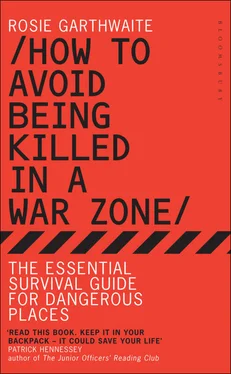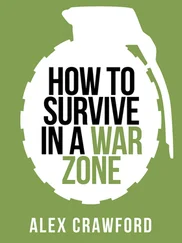• If frostbite is at the first level (numbness or prickliness), you need to put the affected area somewhere warm to heat up slowly. Try your crotch or armpits. If you can’t because your feet are affected, try someone else’s crotch or armpits. Don’t put the frostbitten part close to a fire – it will scream with pain.
• If the frostbite is deep and you cannot warm the area with body heat, warm up some water to just below body temperature, around 30°C – the temperature you bathe a baby in (test it with your elbow) – and put the affected area in it. If it is unbearable, let the water cool and try again, increasing the heat of the water gradually until the area is thawed.
• If the area has started to blister or turn grey or black, you need to protect it from further damage. Do not try to rub the area warm, or burst the blisters, or expose the area to extreme heat. Simply expose the area to body warmth, even if it takes hours. When it has no chance of getting better, blackened areas will just fall off.
Warning:If you are in an enclosed space and trying to warm up with a fire or any other uncovered flame, be aware of the threat of carbon monoxide poisoning. You must keep the area ventilated.
When the feet have been exposed to damp and cold for too long, they develop a condition known as trench foot, which causes them to swell, blister and crack. This makes walking very painful, if not impossible.
One of the most important pieces of kit in a soldier’s bag is a pair of clean socks. The priorities, after water, are feet, food, gun and feet – that’s what you are taught in the British Army.
Preventing trench foot
• Change your socks every day, no matter how tired or wet and cold you are. This will give you a chance to inspect your feet.
• Socks need washing and drying as often as possible. Sleep with them on your hands inside a sleeping bag to help them dry. (It is amazing what you can dry inside a warm sleeping bag overnight.)
• Take plenty of socks if you want to avoid constant laundering.
• Take your shoes and socks off as often as possible and air your feet.
Signs of trench foot
• Feet start to feel numb.
• Pins and needles will develop.
• Sharp pain will rush through your feet.
• The feet will turn purple and blister and crack.
Treatment for trench foot
• Dry the feet and keep them dry.
• Protect the blisters with a dressing. Do not pop them.
• Do not rub or massage the affected area.
• Raise the feet and wrap them loosely in a dry rug or clothing.
• Rest. There is no quick cure for trench foot.
In a very hot environment, water is going to be your main concern. If you’re in an arid desert and have none, the only places worth looking for some are dry streambeds and the lowest area you can find among the dunes. Dig at night, but be careful you are not losing more water (in the form of perspiration) than you are gaining in your efforts to find it. Wadis, oases and bore-holes will be dry and often covered up for most of the year, waiting for the rains to come, but it is worth digging in these places too if you come across them.
Any cuts or sores should be treated and bandaged immediately as they will quickly become infected.
Make a point of finding shelter because without it, your hard-won water will be in vain. Exposure to the heat of the day will soon cause health problems and see you dehydrated even more quickly. At night, when the temperature drops, use the shelter to keep warm.
You will not believe how much water you can get through under certain conditions. When I was in Basra in 2003 the temperature hit 63°C on a day of riots across the city. I was terrified and I was melting. That day I drank eight large bottles of water and I still felt dehydrated after all the kerfuffle was over. My clothes were soaked through, apart from the clear outline of my bra, which – as an extra layer – had absorbed some of the sweat and left a bra-shaped dry patch. My friend Seb’s trousers went from dark blue to white with salt over just a few days in Basra. My trousers eventually disintegrated from being constantly damp, ripping apart as I pulled myself out of a taxi for the tenth time that day. They are a very hardy lot, the Basrawi.
Caroline Hawley was the main BBC correspondent in Iraq while I was out there. I met her once and that was when I first learnt just how swan-like TV reporters really are – calm and authoritative on air, but paddling like crazy things underneath to make the broadcast on time and with the right information at their fingertips. The whole team is working at full speed. And when they’re not working, they are travelling to the next story. As Caroline points out, it is easy to forget the simple parts of life in the rush:
‘I got heatstroke in the summer of 2004. I think it was cumulative. After several days of going out in 45°C heat, I started to feel sick and dizzy. I became delirious and kept telling colleagues, “If my brain goes, put me down.” I could see that what I was saying alarmed them, but I couldn’t help myself repeating the same sentence again and again. I don’t remember ever having felt so ill, and I wound up briefly in the American combat hospital in Iraq. After a break in the cool of the UK, we were out trying to film with an American medical air evacuation team and, unusually, a morning went by with no casualties. We twiddled our thumbs in a stifling pre-fab building with a broken air conditioner. Soon they were laughing at me as I became their first casualty of the day. Three bags of intra-venal fluid later, I was helicoptered back to central Baghdad. I definitely recommend the IV drip – it significantly shortened the recovery time.’
Back in Basra, Seb and I slept outside on the concrete floor, but it had been heated by the day’s sun to around 40°C, so we continued to sweat and barely managed a doze. We experienced all possible heat disorders that week, from prickly heat, which makes you itch and can be relieved only by washing and putting on dry clothes – an impossible dream in Basra – to cramps from lack of salt, heat exhaustion and heatstroke.
Dehydration can happen in cold weather too. The dry air and the physical exertion of fighting the cold means you need to drink more than you otherwise would.
Remember too that diarrhoea, fever and vomiting (all symptoms of cholera, incidentally) can lead to dehydration, as can exercise.
Signs of dehydration
• Dizziness.
• Excessive sweating.
• Disorientation.
• Increasing lethargy.
• Weakened pulse.
• Nausea.
• Unconsciousness.
All these symptoms can be deadly if not treated immediately.
Treatment for dehydration
Almost all the symptoms can be cured by getting out of the sun and slowly drinking water with sugar and a pinch of salt dissolved in it.
Some people are like camels and seem to need very little water, while others need to drink every five minutes. If you are in charge of a team, you should monitor how much and how often people are drinking, and if it is not enough, ignore their protestations and force them to drink. As long as you are not water-boarding them, it is not the torture they claim it to be. In a dangerous situation you need to load up on your water reserves and drink as often as you can because you can never be certain when you might get another chance. Remember, if one colleague collapses from dehydration, it could put the whole team in danger.
Warning:I’m sure I do not need to tell you that alcohol will make all these conditions worse. If you are in a hot region and know you will be exposed to the sun over the next few days, avoid booze. You might want to enforce this rule within your team. Also note that drug-enhanced desert discos are not a good idea, though they always seem like one at the time. The drug Ecstasy can cause dehydration.
Читать дальше




![Джонатан Димблби - Barbarossa - How Hitler Lost the War [calibre]](/books/385421/dzhonatan-dimblbi-barbarossa-how-hitler-lost-the-w-thumb.webp)







